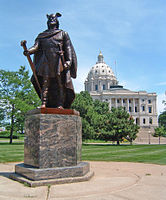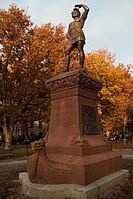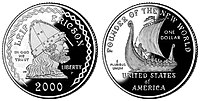Leif Erikson
Leif Erikson | |
|---|---|
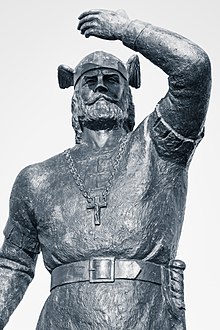 Statue of Leif Erikson in Leif Erikson Park, Duluth, Minnesota | |
| Born | c. 970 |
| Died | c. 1019 to 1025 |
| Nationality | Norse: Icelandic |
| Occupation | Explorer |
| Known for | First European in Vinland (part of North America; probably Newfoundland) |
| Partner | Thorgunna (c. 999) |
| Children | Thorgils, Thorkell |
| Parent(s) | Erik the Red (father) Þjóðhildur (mother) |
| Relatives | Thorvald, Thorstein, and Freydís (siblings) |
Leif Erikson, Leiv Eiriksson, or Leif Ericson,[note 1] also known as Leif the Lucky (c. 970 – c. 1019 to 1025), was a Norse explorer who is thought to have been the first European to have set foot on continental North America, approximately half a millennium before Christopher Columbus.[6][7] According to the sagas of Icelanders, he established a Norse settlement at Vinland, which is usually interpreted as being coastal North America. There is ongoing speculation that the settlement made by Leif and his crew corresponds to the remains of a Norse settlement found in Newfoundland, Canada, called L'Anse aux Meadows, which was occupied 1,000 years ago (carbon dating estimates 990–1050 CE).[8][9][10]
Leif was the son of Erik the Red, the founder of the first Norse settlement in Greenland, and Thjodhild (Þjóðhildur) of Iceland. His place of birth is not known,[11] but he is assumed to have been born in Iceland, which had recently been colonized by Norsemen mainly from Norway.[12][13][14] He grew up in the family estate Brattahlíð in the Eastern Settlement in Greenland. Leif had two known sons: Thorgils, born to noblewoman Thorgunna in the Hebrides; and Thorkell, who succeeded him as chieftain of the Greenland settlement.
Early life
Leif was the son of Erik the Red and his wife Thjodhild, and the grandson of Thorvald Ásvaldsson, and distant relative of Naddodd,[15] who discovered Iceland.[16] His year of birth is most often given as c. 970 or c. 980.[17] Though Leif's birthplace is not accounted for in the sagas,[18] it is likely he was born in Iceland,[12] where his parents met[17]—probably somewhere on the edge of Breiðafjörður, and possibly at the farm Haukadal where Thjóðhild's family is said to have been based.[12] Leif had two brothers, whose names were Thorsteinn and Thorvald, and a sister, Freydís.[19]
Thorvald Ásvaldsson was banished from Norway for manslaughter and went into exile in Iceland accompanied by young Erik. When Erik was banished from Iceland, he travelled further west to an area he named Greenland, where he established the first permanent settlement in 986.[18][20] Tyrker, one of Erik's thralls, had been specially trusted to keep in charge of Erik's children, as Leif later referred to him as his "foster father".[21]
Discovering Vinland
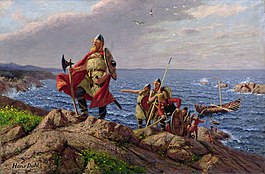


The Saga of Erik the Red and the Saga of the Greenlanders, both thought to have been written around 1200,[23] contain different accounts of the voyages to Vinland (usually interpreted as coastal North America).[24][25] The only two known strictly historical mentions of Vinland are found in the work of Adam of Bremen c. 1075 and in the Book of Icelanders compiled c. 1122 by Ari the Wise.[26]
Account in the Saga of Erik the Red
According to this saga, Leif discovered Vinland after being blown off course on his way from Norway to Greenland.[27] Before this voyage, Leif had spent time at the court of Norwegian King Olaf Tryggvesson, where he had converted to Christianity. When Leif encountered the storm that forced him off course, he (accompanied by a priest) had been on his way to introduce Christianity to the Greenlanders. After they had arrived at an unknown shore, the crew disembarked and explored the area. They found wild grapes, self-sown wheat, and maple trees. Afterwards, they loaded their ship and sailed east to Greenland, rescuing a group of shipwrecked sailors along the way. Leif did not return to Vinland, but others from Greenland and Iceland did, including Thorfinn Karlsefni.[28]
Account in the Saga of the Greenlanders
According to this saga, Leif was not the first European to discover America. Instead Bjarni Herjólfsson and his crew—on a voyage from Iceland to Greenland—were blown off course, missed the southern tip of Greenland, and encountered an unknown coast. Believing it to be somewhere other than Greenland, they did not disembark but rather sailed back east, eventually making it to their original destination, where they told of their discovery.[29]
Leif then approached Bjarni, purchased his ship, gathered a crew of thirty-five men, and mounted an expedition towards the land Bjarni had described.[30] His father Erik was set to join him but dropped out after he fell from his horse on his way to set sail, an incident he interpreted as a bad omen.[31] Leif followed Bjarni's route in reverse and landed first in a rocky and desolate place he named Helluland (Flat-Rock Land; possibly Baffin Island or northern parts of Labrador).[32] After venturing further by sea, he landed the second time in a forested place he named Markland (Forest Land; possibly near Cape Porcupine, Labrador).[32] After two more days at sea, he landed on an island to the north (possibly Belle Isle), and then returned to the mainland, going past a cape on the north side (perhaps Cape Bauld).[32] They sailed to the west of this and landed in a verdant area with a mild climate and plentiful supplies of salmon. As winter approached, he decided to encamp there and sent out parties to explore the country.[32] During one of these explorations, Tyrker discovered that the land was full of vines and grapes. Leif therefore named the land Vinland ('Wineland').[32][33] There, he and his crew built a small settlement, which was called Leifsbudir (Leif's Booths) by later visitors from Greenland.
After having wintered over in Vinland, Leif returned to Greenland in the spring with a cargo of grapes and timber.[30][34] On the return voyage, he rescued an Icelandic castaway and his crew, earning him the nickname "Leif the Lucky".[35] Leif never returned to Vinland, but others from Greenland and Iceland did.
Archeological evidence of Vinland
Research done in the early 1960s by Norwegian explorer Helge Ingstad and his wife, archaeologist Anne Stine Ingstad, identified a Norse site[36] located at the northern tip of Newfoundland. It has been suggested that this site, known as L'Anse aux Meadows, is Leifsbudir. The Ingstads demonstrated that Norsemen had reached America about 500 years before Christopher Columbus.[37][38] Later archaeological evidence suggests that Vinland may have been the areas around the Gulf of St. Lawrence and that the L'Anse aux Meadows site was a ship repair station and waypoint for voyages there. That does not necessarily contradict the identification of L'Anse aux Meadows as Leifsbudir[38][39] since the two sagas appear to describe Vinland as a wider region which included several settlements. The Saga of Erik the Red mentions two other settlements in Vinland: one called Straumfjǫrðr, which lay beyond Kjalarnes promontory and the Wonderstrands, and one called Hóp, which was located even farther south.[40]
Personal life
Leif was described as a wise, considerate, and strong man of striking appearance.[41] During his stay in the Hebrides, he fell in love with a noblewoman, Thorgunna, who gave birth to their son Thorgils.[19] Thorgils was later sent to Leif in Greenland, but he did not become popular.[42]
Leif was converted to Christianity while at the court of Olaf Tryggvason, king of Norway. According to both the Saga of Erik the Red, and Olaf Tryggvason's Saga as found in Heimskringla, after Leif's conversion, the king then commissioned him to return to Greenland to convert the settlers there. During the journey, he was blown off course and discovered Vinland before finding his way to Greenland.[28] Leif's father Erik reacted coldly to the suggestion that he should abandon his religion, while his mother Thjóðhildr became a Christian and built a church called Thjóðhild's Church.[43] A different version of Olaf Tryggvason's Saga, found in Flateyjarbók, makes no reference to Leif being blown off course and discovering Vinland during his return from Norway, but indicates that after arriving in Greenland, all of that country was converted, including Leif's father Erik.[44] The work of Leif and the priest that accompanied him to Greenland would make them the first Christian missionaries to the Americas, preceding the voyages of Christopher Columbus.
Leif is last mentioned alive in 1019, and by 1025 he had passed on his chieftaincy of Eiríksfjǫrðr[18] to another son, Thorkell.[45] Nothing is mentioned about his death in the sagas—he probably died in Greenland some time between these dates.[46] Nothing further is known about his family beyond the succession of Thorkell as chieftain.
Legacy
Norse and medieval Europe

Leif's successful expedition in Vinland encouraged other Norsemen to also make the journey, and the Norse became the first Europeans to colonize the area. In the end there were no permanent Norse settlements, although sporadic voyages at least to Markland for forages, timber and trade possibly lasted for centuries.[47][48] The casual tone of references to these areas may suggest that their discovery was not seen as particularly significant by contemporaries, or that it was assumed to be public knowledge, or both.[26] Knowledge of the Vinland journeys spread around medieval Europe although to what extent is unclear; writers made mention of remote lands to the west, and notably the medieval chronicler Adam of Bremen directly mentions Vinland (c. 1075) based upon reports from the Danes.[note 2] It has been suggested that the knowledge of Vinland might have been maintained in European seaports in the 15th century, and that Christopher Columbus, who claimed in a letter to have visited Iceland in 1477, could have heard stories of it.[49]
Norse encounters with the Indigenous peoples
While Leif had no contact with the Indigenous peoples of Vinland,[50][51] later Norse explorers did, referring to them as skrælingi, an archaic term for "wretches".[52]
According to the Saga of Erik the Red, the first encounter was made during a colonizing expedition led by Thorfinn Karlsefni, which also included Leif's brother Thorvald. At first this group traded with the natives, but weeks later the new Norse settlement was attacked and Karlsefni decided to abandon it. The fleeing Norse continued to explore the general area, and one morning they encountered a one-legged native, who shot an arrow that killed Thorvald.[50] He is famously known for pulling the arrow out, and poetically reciting the phrase, "This is a rich country we have found; there is plenty of fat around my entrails", upon which he dies.[52] On their return to Greenland, Karlesefni's crew capture two native boys, taking them to Greenland.[50]
According to the Saga of the Greenlanders, Leif's brother Thorvald made first contact with the natives.[49] The encounter happened while Thorvald and his crew were exploring the coast, likely in the Markland area, and found nine natives asleep under boats. They attacked the natives, killing eight of them, while one escaped. In a later fight, Thorvald was killed by a native's arrow. Later, Thorfinn Karlsefni led a group to colonize Vinland and encountered natives, who they initially traded with, but relations soured when a native was killed attempting to steal weapons from the Norse. In retaliation, the natives attacked and Karlsefni decided to abandon the colony.[50]
Travels and commemoration
Stories of Leif's journey to North America had a profound effect on the identity and self-perception of later Nordic Americans and Nordic immigrants to the United States.[20] The first statue of Erikson (by Anne Whitney)[53] was erected in Boston in 1887 at the instigation of Eben Norton Horsford, who was among those who believed that Vinland could have been located on the Charles River or Cape Cod;[20] not long after, another casting of Whitney's statue was erected in Milwaukee.[54] A statue was also erected in Chicago in 1901, having been originally commissioned for the 1893 World's Columbian Exposition to coincide with the arrival of the reconstructed Viking ship from Bergen, Norway.[20] Another work of art made for the 1893 World's Columbian Exposition, the painting Leiv Eirikson Discovering America by Christian Krohg, was in the possession of a Leif Erikson Memorial Association in Chicago before being given back to the National Gallery of Norway in 1900.[55]
For the centenary of the first official immigration of Norwegians to America, President Calvin Coolidge stated at the 1925 Minnesota State Fair, to a crowd of 100,000 people, that Leif had indeed been the first European to discover America.[20] Additional statues of him were erected at the Minnesota State Capitol in St. Paul in 1949, near Lake Superior in Duluth, Minnesota, in 1956, and in downtown Seattle.[20]
In 1924, a party of four consisting of a Swede, an Englishman, and two Americans attempted to emulate Leif's voyage in an eponymous 40-foot vessel but were lost after reaching the west coast of Greenland.[56]: 267
In 1930, a statue of Leif was erected in the city center of Reykjavík, Iceland – currently situated in front of Hallgrímskirkja – as a gift from the United States to Iceland to commemorate the 1,000 year anniversary of Alþingi, the parliament of Iceland.[57]
The Leif Erikson Awards, established 2015, are awarded annually by the Exploration Museum in Húsavík, Iceland. They are awarded for achievements in exploration and in the study of the history of exploration.[58]
Several ships are named after Leif – a Viking ship replica, a commercial passenger/vehicle ferry,[59][60] and a large dredger.[61]
Leif Erikson Day
In 1929, the Wisconsin Legislature passed a bill to make 9 October "Leif Erikson Day" in the state.[62] In 1964, the United States Congress authorized and requested the president to proclaim 9 October of each year as "Leif Erikson Day".[20] On 6 October 2000 President Bill Clinton issued Presidential Proclamation 7358, proclaiming Monday, 9 October 2000 as Leif Erikson Day.[63]
The Sagas do not give the exact date of Leif's landfall in America, but state only that it was in the fall of the year. At the suggestion of Christian A. Hoen of Edgerton, Wisconsin, 9 October was settled upon, as that already was a historic date for Norwegians in America, the ship Restaurationen having arrived in New York Harbor on 9 October 1825[62][64] from Stavanger with the first organized party of Norwegian immigrants.[citation needed]
Gallery of art and sculptures
-
The Landing of the Vikings by Arthur C. Michael (1919)
-
Leif Erikson memorial statue at Shilshole Bay Marina, Port of Seattle
-
Leif Eriksson Memorial (1929–1932), Reykjavík, Iceland. This statue is at the front of the Hallgrímskirkja. There is a copy of this statue in Newport News, Virginia, USA.[65]
-
Leif Erikson by John K. Daniels, 1948–49, near the Minnesota State Capitol.
-
The oldest public statue of Leif, placed in Boston in 1887.
-
A 'Leif Ericson' proof dollar from the United States, minted in 2000. It reads 'Founder of the New World'
In fiction
- Leif is the main character in the 1928 film The Viking.[66]
- In children's literature, Leif the Lucky written and illustrated by Ingri and Edgar Parin d'Aulaire. Published by Doubleday & Company, inc., 1941.[67]
- Leif is one of the main characters in Makoto Yukimura's manga Vinland Saga.[68]
- Leif is the main character in the juvenile historical novel Vinland the Good. The author is Henry Treece, and it is illustrated by William Stobbs. It is an account of Viking Era explorations, based mainly on the Greenland saga.[69]
- An Old Captivity is a novel which involves a dream sequence featuring a character called Leif Ericson. Notably, it also features an attempt to uncover historical Viking settlements using air surveys. It was written by Nevil Shute and published in 1940.[70]
- Leif is a main character in the 2022 Netflix historical drama series Vikings: Valhalla played by Sam Corlett.[71]
See also
- Alonso Sánchez, a Spanish navigator who purportedly visited the Americas before Columbus
- Jean Cousin, a French navigator with a similar claim
- Brendan Saint Brendan and his legendary voyage
- Leif Erikson Awards
- Leif Ericson Millennium commemorative coins
- Kunyu Wanguo Quantu, 1602 Chinese world map purportedly transcribed with Chinese data from 1430
Notes
- ^ The patronym is Anglicized in various ways in the United States; according to one source, Leif Ericson is the most common rendering on the East Coast, while Leif Erikson is the most common rendering on the West Coast.[1] Erikson is the spelling widely used and recognized by many others.[2][3][4][5] Old Norse: Leifr Eiríksson [ˈlɛivz̠ ˈɛiˌriːksˌson]; Modern Icelandic: Leifur Eiríksson [ˈleiːvʏr ˈeiːˌriksˌsɔːn]; Norwegian: Leiv Eiriksson
- ^ Adam mentions Vinland (Winland) in Chapter 39 of Book IV of his Gesta: 'In addition, he [i.e., Sweyn Estridsson, king of Denmark (reigned 1047–1076)] named one more island in this ocean, discovered by many, which is called "Vinland", because vines grow wild there, making the best wine. For [that] crops [that are] not sown, abound there, we learn not from fanciful opinion but from the true account of the Danes.' Adam von Bremen (1917). Schmeidler, Bernhard (ed.). Hamburgische Kirchengeschichte [Hamburg's Church History] (in Latin and German). Hannover and Leipzig, Germany: Hahnsche. pp. 275–276.
References
- ^ Leander, Kristine (2008). Norwegian Seattle. Arcadia Publishing. p. 63. ISBN 978-0-7385-5960-5. Archived from the original on 28 April 2022. Retrieved 19 November 2015.
- ^ "Turning over a new Leif". Leif Erikson International Foundation. Archived from the original on 26 December 2018. Retrieved 23 March 2014.
- ^ Leif Erikson Issue. Smithsonian Institution. Archived from the original on 2 February 2016. Retrieved 23 March 2014.
- ^ "History". Sons of Norway. Archived from the original on 26 December 2018. Retrieved 23 March 2014.
- ^ Norwegian-American Studies, Volumes 1–3. Norwegian-American Historical Association. 1926. Archived from the original on 15 August 2021. Retrieved 11 October 2020.
- ^ "Leif Erikson (11th century)". BBC. Archived from the original on 6 October 2018. Retrieved 20 November 2011.
- ^ "Why Do We Celebrate Columbus Day and Not Leif Erikson Day?". National Geographic. 11 October 2015. Archived from the original on 26 December 2018. Retrieved 12 October 2015.
- ^ Nydal, Reidar (1989). "A Critical Review of Radiocarbon Dating of a Norse Settlement at L'Anse Aux Meadows, Newfoundland Canada". Radiocarbon. 31 (3): 976–985. doi:10.1017/S0033822200012613. eISSN 1945-5755. ISSN 0033-8222. Archived from the original on 22 November 2021. Retrieved 2 December 2021.
With an assumed total systematic error of 30 ± 20 years, as a mean for various tree rings, the calibrated age range of L'Anse aux Meadows is AD 975–1020. This agrees well with the assumed historical age of ca AD 1000, a result which has also been recently corroborated by high-precision accelerator dating at the University of Toronto.
- ^ Cordell, Linda S.; Lightfoot, Kent; McManamon, Francis; Milner, George (2009). "L'Anse aux Meadows National Historic Site". Archaeology in America: An Encyclopedia. ABC-CLIO. p. 82. ISBN 978-0-313-02189-3. Archived from the original on 30 December 2016. Retrieved 24 February 2021.
This is a substantial base for analysis, which yields an entirely credible range of dates between 990 and 1050 and a mean date of 1014 CE, which is popularly rounded off at 1000 CE .
- ^ Ledger, Paul M.; Girdland-Flink, Linus; Forbes, Véronique (15 July 2019). "New horizons at L'Anse aux Meadows". Proceedings of the National Academy of Sciences. 116 (31): 15341–15343. doi:10.1073/PNAS.1907986116. eISSN 1091-6490. ISSN 0027-8424. PMC 6681721. PMID 31308231.
Modeling results were remarkably consistent, and model A suggests Norse occupation began Cal AD 910–1030..... A weighted mean of twig dates—notwithstanding issues associated with combination of 14C ages from multiple individuals—provided a result of AD 986–1022
- ^ Leiv Eriksson Archived 5 August 2017 at the Wayback Machine, Norsk biografisk leksikon
- ^ a b c Sverrir Jakobsson (14 July 2001). "Shouldn't Leifr Eiríksson ('Leif the Lucky') really be viewed as a Greenlander with family roots in Iceland and Norway?". Translated by Nicholas Jones, 25 November 2005. The Icelandic Web of Science. Archived from the original on 3 January 2022. Retrieved 3 January 2022.
- ^ Leif Eriksson Archived 3 October 2013 at the Wayback Machine – Encyclopædia Britannica, Inc., 2012. Retrieved 11 April 2012.
- ^ "Congressional Record, V. 145, Pt. 21, November 17, 1999 to December 3, 1999". Government Printing Office. Archived from the original on 9 October 2021. Retrieved 11 October 2020 – via Google Books.
- ^ "Thorvald Asvaldsson | Mediander | Connects". Mediander. Archived from the original on 28 August 2017. Retrieved 26 October 2015.
- ^ "The Discovery of Iceland". www.viking.no. Archived from the original on 11 July 2011. Retrieved 26 October 2015.
- ^ a b Sanderson, Jeanette. (2002) Explorers, Teaching Resources/Scholastic. p. 14. ISBN 0-439-25181-8.
- ^ a b c "Leiv Eiriksson". Store norske leksikon (in Norwegian). Archived from the original on 5 August 2017. Retrieved 13 November 2011.
- ^ a b Ingstad, Helge; Ingstad, Anne Stine (2000). The Viking discovery of America: the excavation of a Norse settlement in L'Anse aux Meadows, Newfoundland. Breakwater Books. p. 74. ISBN 978-1-55081-158-2. Archived from the original on 24 February 2022. Retrieved 19 November 2015.
- ^ a b c d e f g Dregni, Eric (2011). Vikings in the attic: in search of Nordic America. U of Minnesota Press. pp. 72–73. ISBN 978-0-8166-6744-4. Archived from the original on 21 May 2022. Retrieved 19 November 2015.
- ^ Wiesner, Merry E.; Wiesner-Hanks, Merry E.; Wheeler, William Bruce; Doeringer, Franklin; Curtis, Kenneth R. (2011). Discovering the Global Past. Cengage Learning. p. 158. ISBN 978-1-111-34142-8. Archived from the original on 23 May 2022. Retrieved 19 November 2015.
- ^ Magazine, Smithsonian; Handwerk, Brian. "New Dating Method Shows Vikings Occupied Newfoundland in 1021 C.E." Smithsonian Magazine. Archived from the original on 7 April 2022. Retrieved 10 April 2022.
- ^ Lindkvist, Thomas (2003). "Early political organisation". In Helle, Knut (ed.). The Cambridge History of Scandinavia: Prehistory to 1520. Cambridge University Press. p. 212. ISBN 978-0-521-47299-9.
- ^ Somerville & McDonald, 2010, p. 350.
- ^ Short, 2010, p. 203.
- ^ a b "Vinland History". National Museum of Natural History. Smithsonian Institution. Archived from the original on 26 November 2011. Retrieved 23 November 2011.
- ^ Somerville & McDonald, 2010, pp. 419–420.
- ^ a b Campbell, Gordon (2021). Norse America: The Story of a Founding Myth. Oxford: Oxford University Press. pp. 37–38. ISBN 978-0-19-886155-3.
- ^ Campbell, Gordon (2021). Norse America: The Story of a Founding Myth. Oxford: Oxford University Press. pp. 35–37. ISBN 978-0-19-886155-3.
- ^ a b Short, 2010, pp. 203–204.
- ^ Somerville & McDonald, 2010, p. 352.
- ^ a b c d e Wernick, Robert (1979). The Vikings. Alexandria, VA: Time-Life Books. pp. 149–151. ISBN 0-8094-2709-5.
- ^ Kudeba, N. (19 April 2014). Chapter 5 – Norse Explorers from Erik the Red to Leif Erikson – Canadian Explorers. Retrieved from The History of Canada: "Chapter 5 – Norse Explorers from Erik the Red to Leif Erikson – Canadian Explorers | the History of Canada". Archived from the original on 8 May 2014. Retrieved 22 April 2014.
- ^ Somerville & McDonald, 2010, pp. 352–354.
- ^ Somerville & McDonald, 2010, p. 354.
- ^ "L'Anse aux Meadows". L'Anse aux Meadows National Historic Site of Canada. Parks Canada. 2018. Archived from the original on 9 December 2019. Retrieved 21 December 2018.
Here [L'Anse aux Meadows] Norse expeditions sailed from Greenland, building a small encampment of timber-and-sod buildings …
- ^ "Helge Ingstad". The Telegraph. 30 March 2001. Archived from the original on 11 January 2022. Retrieved 20 November 2011.
- ^ a b Short, 2010, p. 207.
- ^ "Vinland Archeology". National Museum of Natural History. Smithsonian Institution. Archived from the original on 9 December 2003. Retrieved 21 November 2011.
- ^ "Vinland Sagas". National Museum of Natural History. Smithsonian Institution. Archived from the original on 23 December 2015. Retrieved 21 November 2011.
- ^ "Leif Eriksson | The Canadian Encyclopedia". www.thecanadianencyclopedia.ca. Archived from the original on 13 April 2021. Retrieved 24 February 2021.
- ^ "Leif Eiriksson, "Leif the Lucky" (Leifr Eiríksson, nicknamed, Leifr hin heppni)". Great Unsolved Mysteries in Canadian History: Where is Vinland?. Archived from the original on 9 December 2016. Retrieved 21 November 2011.
- ^ Somerville & McDonald, 2010, p. 420.
- ^ Reeves, Arthur Middleton (1890). The finding of Wineland the Good : the history of the Icelandic discovery of America. London: H. Frowde, Oxford University Press. p. 57.
- ^ Seaver, Kirsten A. (1997). The frozen echo: Greenland and the exploration of North America, ca. A.D. 1000–1500. Stanford University Press. p. 62. ISBN 978-0-8047-3161-4. Archived from the original on 20 December 2019. Retrieved 19 November 2015.
- ^ Hermannsson, Halldór (1936). The problem of Wineland, Volume 1; Volume 25. Cornell University Press. ISBN 978-0527003555. Archived from the original on 19 August 2021. Retrieved 19 November 2015.
- ^ Schledermann, Peter. (1996). Voices in Stone. A Personal Journey into the Arctic Past. Komatik Series no. 5. Calgary: The Arctic Institute of North America and the University of Calgary.
- ^ Sutherland, Patricia. (2000). "The Norse and Native Norse Americans". In William W. Fitzhugh and Elisabeth I. Ward, eds., Vikings: The North Atlantic Saga, pp. 238–247. Washington, DC: The Smithsonian Institution.
- ^ a b Short, 2010, pp. 203–206.
- ^ a b c d McGhee, Robert (January 1984). "Contact between Native North Americans and the Medieval Norse: A Review of the Evidence". American Antiquity. 49 (1): 4–26. doi:10.2307/280509. JSTOR 280509. S2CID 163333983.
- ^ Warden, Donald E. (August 2016). "The Extent of Indigenous-Norse Contact and Trade Prior to Columbus". Oglethorpe Journal of Undergraduate Research. 6 (1). Archived from the original on 18 December 2021. Retrieved 18 December 2021. p. 7:
Leif did not encounter any Indigenous people over the entire voyage
- ^ a b Weaver, Jace (2011). The red atlantic. American Indian Quarterly. pp. 418–463, 477.
- ^ Forbes, Alan and Ralph M. Eastman, "Some Statues of Boston: Reproductions of some of the statues for which Boston is famous, with information concerning the personalities and events memorialized", State Street Trust Company, Boston MA 1946 and Forbes, Alan and Ralph M. Eastman, "Other Statues of Boston", State Street Trust Company, Boston MA 1947.
- ^ Buck, Diane M; Palmer, Virginia A (1995). Outdoor Sculpture in Milwaukee: A Cultural and Historical Guidebook. Madison: The State Historical Society of Wisconsin. pp. 9–12. ISBN 978-0-87020-276-6.
- ^ "Leiv Eiriksson oppdager Amerika". Store norske leksikon (in Norwegian). Oslo: Kunnskapsforlaget. Archived from the original on 4 October 2013. Retrieved 2 December 2011.
- ^ Thomas, Lowell (1925). The First World Flight. Boston & New York: Houghton Mifflin Company.
- ^ Helgason, Magnús Sveinn; Eliason, Matt; McMahon, Sara; Sigurþórsdóttir, Sunna Karen (2 November 2015). "Ten fascinating facts about the statue of Leifur Eiríksson". Icelandmag. Archived from the original on 8 March 2021. Retrieved 16 June 2020.
- ^ "The Exploration Awards – The Exploration Museum". Archived from the original on 31 March 2022. Retrieved 30 March 2022.
- ^ "MV Leif Ericson Ferry – Vessel Information | Marine Atlantic". www.marineatlantic.ca. Archived from the original on 19 March 2021. Retrieved 30 March 2021.
- ^ "Leif Ericsson (Ro-Ro/Passenger Ship) Registered in Canada – Vessel details, Current position and Voyage information – IMO 8917388, MMSI 316001216, Call Sign VOCJ". www.marinetraffic.com. Archived from the original on 15 April 2021. Retrieved 30 March 2021.
- ^ "The world's largest dredger in the Gulf of Gdansk". Poland at Sea – maritime economy portal. 11 June 2019. Archived from the original on 25 February 2020. Retrieved 30 March 2021.
- ^ a b Hansen, Carl Gustav Otto (1956). My Minneapolis: A Chronicle of what Has Been Learned and Observed about the Norwegians in Minneapolis Through One Hundred Years. Privately published.
- ^ "Leif Erikson Day, 2000" (PDF). Federal Register. 65 (198). 6 October 2000. Archived (PDF) from the original on 21 October 2020. Retrieved 4 January 2021.
- ^ Obama, Barack (7 October 2009). "Leif Erikson Day, 2009" (Press release). White House Office of the Press Secretary. Archived from the original on 14 February 2017. Retrieved 20 November 2011.
- ^ "Leif Erikson statue". alamy. Archived from the original on 13 July 2020. Retrieved 13 July 2020.
- ^ Hall, Mordaunt (29 November 1928). "A Picture in Colors". The New York Times. New York City. Archived from the original on 12 July 2020. Retrieved 30 November 2019.
- ^ "Leif the Lucky". Adlibris (in Swedish). 15 October 2014. Archived from the original on 22 September 2022. Retrieved 20 April 2022.
- ^ Harris, Will (31 July 2019). "Amazon's Vinland Saga Anime Is a Classic Anime in the Making". IGN Southeast Asia. Archived from the original on 9 January 2021. Retrieved 22 August 2020.
- ^ William Stobbs, Henry Treece. "Vinland the Good". childrensbookshop.com. Puffin. Archived from the original on 7 March 2021. Retrieved 23 August 2020.
- ^ Shute, Nevil. "An Old Captivity". fadedpage.com. William Morrow & Company. Archived from the original on 13 August 2020. Retrieved 23 August 2020.
- ^ "Sam Corlett Gets Spiritual as Leif Eriksson in 'Vikings: Valhalla'". Netflix Tudum. 1 March 2022. Archived from the original on 31 March 2022. Retrieved 31 March 2022.
Bibliography
- Short, William R. (2010). Icelanders in the Viking age: the people of the sagas. McFarland. ISBN 978-0-7864-4727-5. Archived from the original on 21 May 2022. Retrieved 19 November 2015.
- Somerville, Angus; McDonald, Andrew R. (2010). The Viking Age: A Reader. University of Toronto Press. ISBN 978-1-4426-0148-2. Archived from the original on 24 January 2021. Retrieved 19 November 2015.
External links
 Media related to Leifur Eiríksson at Wikimedia Commons
Media related to Leifur Eiríksson at Wikimedia Commons- Works about Leif Erikson at Open Library
- Template:Worldcat subject
- Beazley, Charles Raymond (1911). . Encyclopædia Britannica. Vol. 16 (11th ed.). p. 396.
- Leif Erikson
- 970s births
- 1020s deaths
- 10th-century Christians
- 10th-century Icelandic people
- 11th-century Christians
- 11th-century Icelandic people
- Converts to Christianity from pagan religions
- Greenlandic Christians
- Explorers of Canada
- Icelandic explorers
- Icelandic sailors
- Viking Age in Canada
- Scandinavian explorers of North America
- Viking explorers
- 10th-century explorers
- 9th-century Vikings
- 10th-century Vikings


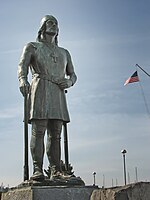
![Leif Eriksson Memorial (1929–1932), Reykjavík, Iceland. This statue is at the front of the Hallgrímskirkja. There is a copy of this statue in Newport News, Virginia, USA.[65]](http://upload.wikimedia.org/wikipedia/commons/thumb/6/6e/Leifur_heppni_%28603381304%29.jpg/150px-Leifur_heppni_%28603381304%29.jpg)
